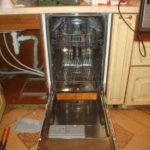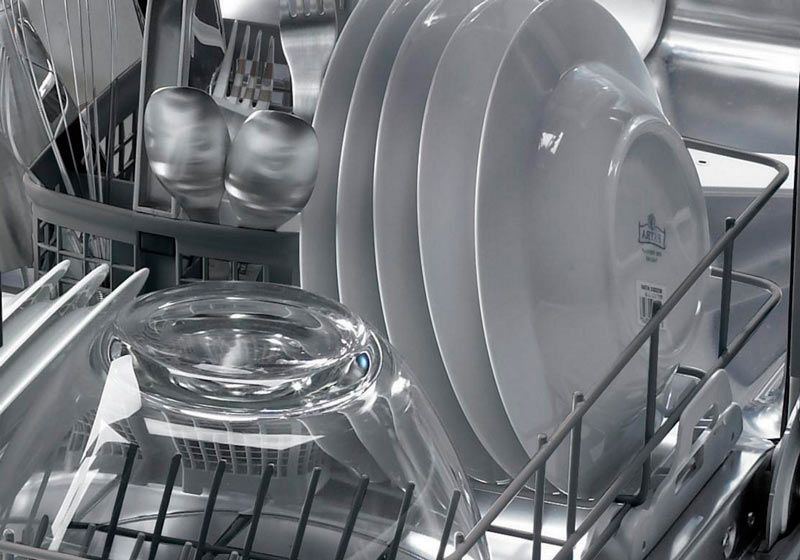How to choose a dishwasher
Washing dishes is not a particularly exciting activity. If there is a choice, then any sane person will do something more interesting at this time. Therefore, the demand for dishwashers is steadily increasing, because they save not only time, but also water. The article will evaluate the criteria for choosing a dishwasher for the home, and indicate some nuances when choosing equipment.
The content of the article
Which dishwasher is better if it is not planned to be used daily?
 Firstly, a decent amount of dirty dishes can accumulate over a few days. Several people may come to visit, and the number will increase sharply - you won’t feed guests soup and then dumplings from the same dish. This means that the capacity of the loading chamber should be two or three times the required minimum. There is no need to buy a car with a huge number of modes - five or six will be enough, the rest will not be in demand.
Firstly, a decent amount of dirty dishes can accumulate over a few days. Several people may come to visit, and the number will increase sharply - you won’t feed guests soup and then dumplings from the same dish. This means that the capacity of the loading chamber should be two or three times the required minimum. There is no need to buy a car with a huge number of modes - five or six will be enough, the rest will not be in demand.
In terms of the level of noise produced, the PMM should not exceed 45 dB, otherwise it will be annoying.If you plan to dry dishes without haste, then a device with condensation drying is quite suitable; this mode will also save energy. It is also important to take into account the dimensions of the PMM, so as not to clutter up the kitchen as much as possible, but more on that later.
Which dishwasher to choose depending on the size of the kitchen
If the kitchen is small, the answer is clear: you need to purchase a built-in dishwasher. The advantages, in addition to saving space, are:
- reduction of noise level due to embedding;
- aesthetic appearance;
- availability of a large model range.
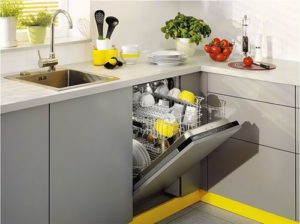 If the kitchen is spacious, you can opt for a free-standing dishwasher. As a rule, such devices have a larger loading chamber capacity and, accordingly, greater productivity than built-in models. Such machines are installed in kitchens where renovations have already been completed and you don’t want to bother with integrating PMM into existing interior items, and remodeling is not planned in the near future. There are free-standing PMMs that are installed under the tabletop, but are not part of the furniture.
If the kitchen is spacious, you can opt for a free-standing dishwasher. As a rule, such devices have a larger loading chamber capacity and, accordingly, greater productivity than built-in models. Such machines are installed in kitchens where renovations have already been completed and you don’t want to bother with integrating PMM into existing interior items, and remodeling is not planned in the near future. There are free-standing PMMs that are installed under the tabletop, but are not part of the furniture.
There are also tabletop options comparable in size to a microwave or electric oven. Such machines are suitable for small families of 2-3 people due to their low productivity. The advantage of such devices is their compactness and the ability to install them anywhere in the kitchen.
How to choose a built-in dishwasher
Built-in dishwasher 45 cm and 60 cm: which is better
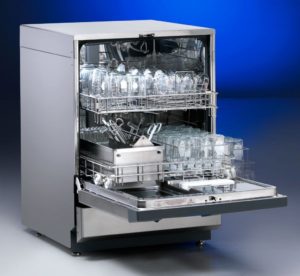 For each individual case the answer will be different. In order: the 45 cm dishwasher has a smaller loading chamber (up to 8 sets), but saves space for other built-in appliances in the kitchen.Uses less water and electricity than a full-size dishwasher. Suitable for a small family, up to 5 people.
For each individual case the answer will be different. In order: the 45 cm dishwasher has a smaller loading chamber (up to 8 sets), but saves space for other built-in appliances in the kitchen.Uses less water and electricity than a full-size dishwasher. Suitable for a small family, up to 5 people.
A built-in dishwasher with a width of 60 cm, as a rule, has more operating modes and greater productivity, but they take up more space when built into the interior, and, accordingly, consume relatively a lot of electricity and water. Such a device is best suited for large families, as well as for frequent receptions.
What to look for when buying a built-in dishwasher
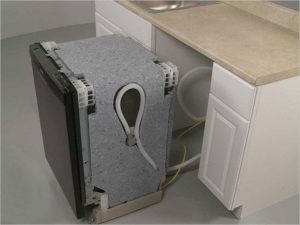 The first thing you need to know is the capacity of the loading chamber. Depending on it, a suitable model is selected. There are three main PMM standards with approximate dimensions: full-size - 600 x 600 x 850 mm; narrow – 450 x 600 x 850 mm; compact – 450 x 450 x 500 mm.
The first thing you need to know is the capacity of the loading chamber. Depending on it, a suitable model is selected. There are three main PMM standards with approximate dimensions: full-size - 600 x 600 x 850 mm; narrow – 450 x 600 x 850 mm; compact – 450 x 450 x 500 mm.
According to water consumption PMM are divided into classes A (15 l), B (20 l), C (25 l and more) depending on the water consumption per dishwashing cycle. In terms of energy consumption, class A is the most economical, and this is where you should choose.
Types of drying – condensation, intensive or turbo drying. The longest drying option is the first, but the minimum amount of electricity is consumed; with intensive drying, normal air is pumped into the chamber, with turbo - heated air. PMMs with turbo drying are the most expensive and energy-consuming, although they dry dishes quickly.
Connection methods – to which water supply system – hot or cold – will the dishwasher be connected. Cold water contains fewer impurities, but the energy consumption for heating it increases. Hot water has an operating temperature range of 40–70 degrees, and it is not available everywhere. The best option is to connect both hot and cold water through a mixer.
Noise level – varies among different models from 38 to 55 decibels. Machines with a noise level not exceeding 45 dB are preferred, otherwise their operation will cause discomfort.
The following safety requirements are relevant:
- The machine door must have an opening lock during operation;
- Protection against leaks can be complete or partial. High-quality models have full protection. In this case, sensors are installed in the pan and at the end of the hose, which detect leaks and send a signal to the valve to shut off the water supply. When installing partial protection (in inexpensive models), the sensor is mounted in a tray. The protection is only triggered when the pan is overfilled.
- Grounding and circuit breaker. A device connected to the power supply and working with water poses an increased danger. It makes sense to run the PMM its own power supply line from a meter with a circuit breaker, and ground it properly.
Choosing a dishwasher: main criteria
Kitchen size
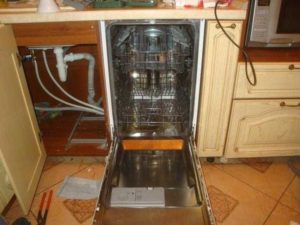 As described above, dishwashers are divided into built-in, free-standing and compact, or tabletop. Depending on the size of the kitchen, you can give preference to one or another PMM model, but the main criterion for its selection is compliance with the stated requirements for water and electricity consumption, as well as performance.
As described above, dishwashers are divided into built-in, free-standing and compact, or tabletop. Depending on the size of the kitchen, you can give preference to one or another PMM model, but the main criterion for its selection is compliance with the stated requirements for water and electricity consumption, as well as performance.
In order to save space, does it make sense to take a compact machine that will work continuously in a large family? Hardly. It would also be pointless to purchase a full-size dishwasher with a chamber loading capacity of 17 sets for a spacious kitchen, but for a family of two.
Purpose in the house
An important parameter is the number of sets of cutlery that can be washed in one cycle. The cutlery set consists of a cup and saucer, shallow and deep plates, as well as a knife and fork. Based on this, when washing dishes, one person should have at least two, and preferably three, sets per cycle. Compact PMMs can handle 5–6 sets at a time, narrow ones 8–10, and full-size ones 11–18 sets.
Therefore, it turns out that compact machines are suitable for a family of 1-2 people, narrow ones can handle serving 3-4 people, and full-size ones are well suited for families of 5 or more people.
Functional loads
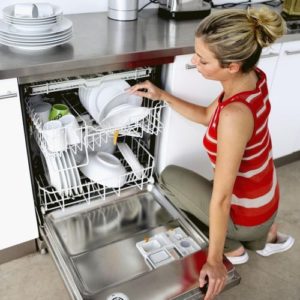 In order to save space in the kitchen, a large family can purchase and use a compact dishwasher, but energy costs will increase significantly. In addition, every mechanism has its own motor resource, after which it fails. You can also use a full-size machine with a partial load if you have a small family. But then water consumption will increase.
In order to save space in the kitchen, a large family can purchase and use a compact dishwasher, but energy costs will increase significantly. In addition, every mechanism has its own motor resource, after which it fails. You can also use a full-size machine with a partial load if you have a small family. But then water consumption will increase.
Therefore, in order to avoid unnecessary expenses, before purchasing a dishwasher, you need to think about what the family’s actual needs for washing dishes are. In terms of the number of operating modes, you can settle on a simple model with 5–6 basic functions. This whole mountain of electronics is sensitive to voltage drops in the network, which is a problem with the domestic power supply system.

